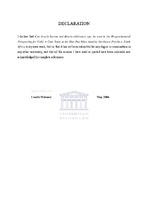| dc.contributor.advisor | Okujeni, Charles | |
| dc.contributor.author | Mshumi, Unathi | |
| dc.contributor.other | Dept. of Earth Science | |
| dc.contributor.other | Faculty of Science | |
| dc.date.accessioned | 2013-06-27T06:55:10Z | |
| dc.date.available | 2007/04/05 07:57 | |
| dc.date.available | 2007/04/05 | |
| dc.date.available | 2013-06-27T06:55:10Z | |
| dc.date.issued | 2006 | |
| dc.identifier.uri | http://hdl.handle.net/11394/1577 | |
| dc.description | Magister Scientiae - MSc | en_US |
| dc.description.abstract | In areas of transported overburden there is frequently a weak relationship between soil and the underlying mineralized bedrock. Vegetation has the capability to absorb metals from the underlying substrate via its extensive root systems. These metals are translocated to the various organs of the plant such as leaves, twigs bark and roots without negatively impacting on the normal functioning of the plant. The analysis of the vegetation may therefore be used to locate deeply buried mineral targets. The main focus of this investigation was to determine the suitability of A. karroo and B. albitrunca for biogeochemical prospecting for gold in the Blue Dot Mine area. The appraisal of the suitability for both plant species requires an understanding of element absorption and distribution patterns in relation to variable composition of bedrock and associated underlying gold mineralization. | en_US |
| dc.language.iso | en | en_US |
| dc.publisher | University of the Western Cape | en_US |
| dc.subject | Biogeochemical prospecting | en_US |
| dc.subject | South Africa | en_US |
| dc.subject | Northwest Province | en_US |
| dc.subject | Geobotanical prospecting | en_US |
| dc.title | Can Acacia Karroo and Boscia Albitrunca be used in the biogeochemical prospecting for gold :a case study at the Blue Dot Mine, Amalia, Northwest province, South Africa | en_US |
| dc.type | Thesis | en_US |
| dc.rights.holder | University of the Western Cape | en_US |
| dc.description.country | South Africa | |

